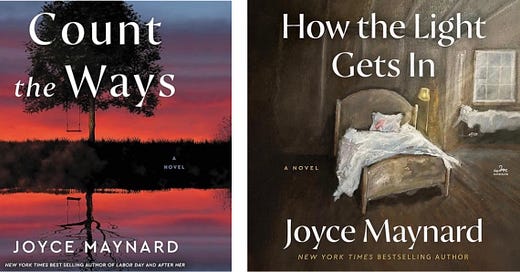BookLife Dual Review by Carol O’Day: Count the Ways and How the Light Gets In (Joyce Maynard, author)
Contemporary fiction, mature protagonist, accidental injury, blame, divorce, trauma, bitterness, forgiveness, parenthood, artist, infidelity, self-discovery, renewal.
How the Light Gets In is Joyce Maynard’s continuation of the story at the heart of Maynard’s prior novel, Count the Ways. Though each of the novels is a multi-layered exploration of family, divorce, healing and self-discovery, the second of the novels contains significant overlap and retelling of plot lines of the first. The central character of both novels, Eleanor, is a compelling character; we follow Eleanor from her teen years through marriage, motherhood and a difficult divorce. In Count the Ways, Maynard documents Eleanor’s flaws and missteps in her parenting and marriage with a candor that is at once excruciating and refreshing. In How the Light Gets In, Maynard tackles her protagonist’s journey of later-in-life as a divorced single mother with estranged children, through self-reflection and self-discovery, a story arc too infrequently portrayed in contemporary fiction. Maynard embraces the flaws and errors that occur in Eleanor’s life, marriage and parenting in a way that makes her supremely human, relatable and sympathetic.
The significant recounting of Count the Ways’ key plot lines stalls the rhythm and progression of the new storylines in How the Light Gets In. Writing a series with recurring characters is no doubt challenging, but Maynard’s second novel falters a bit here, because of the repetition and retelling. In some senses, Count the Ways stands alone as the stronger story, despite the fact that the open-endedness of its ending practically begs for a sequel. How the Light Comes In introduces new characters, plays out the outcomes of the lives of the now adult children we met in the first novel, and provides a welcome platform for Eleanor to forgive herself, accept her life as it has unfolded and re-discover herself. Each has merits; the two novels each just suffer a bit when read in tandem.
In Count the Ways, we meet Eleanor as an orphaned nineteen year-old buying herself a home in New Hampshire. At 19, Eleanor already is a successful artist and author of a series of children’s books. She purchases a farm and an older house where she hopes to raise a family. She restores the aged home she purchased and meets and falls in love with Cameron, a charming woodworking artist who fashions bowls and other objects out of burled wood. The two marry and have three children. Eleanor revels in motherhood and at the same time struggles to support the household as the primary earner. Cam is the fun and carefree parent, with little worry or concern about money. A tragic accident leaves their youngest child with a traumatic brain injury. Their marriage strains and ultimately crashes under the weight of the tragic brain-injury incident involving their four year-old son. Blame, an affair, and an inability to forgive ultimately doom the marriage. The divorce is complicated and the couple fails to be truthful with their children, an error that has lifelong implications for the relationship of the children with their mother.
The family farm is a pivotal element of the story and a character of sorts itself. It is a place of wonder, play, exploration of nature, a goat farm, a physical therapy and massage studio, an artist’s studio, and later a successful cheese business. It adjoins an iconic waterfall, and a pond. It is a place that forms all of the members of the family and the place where all of the members of the family grow, fail, hurt, love and leave and return. Eleanor buys the farm, shares it with Cam, raises her children there, leaves it to Cam to raise their children on, returns for their marriages and to care for an ailing ex-husband and to steward her youngest son into adulthood.
The novels contain a strong secondary story, the transgender transition of Eleanor and Cam’s oldest child from female to male. Allison's journey to become Al is emblematic of the arc of self-discovery that each of the story’s primary characters experience–the journey to become his truest, most fully realized self. He is a pioneer on that journey, one that his mother, sister and brothers each travel to shed parts of their past that they outgrow in order to find peace and acceptance. Maynard also tackles the challenging topic of parent-child estrangement, one which is not unusual in difficult divorces but is often an untouched third-rail in contemporary fiction. Maynard resists the urge to oversimplify Eleanor’s relationship with Ursula and the impact of the significant trauma Ursula suffered in connection with her brother’s brain injury and parents’ subsequent divorce, both before she was seven years old. Her anger and resentment are real, despite the faulty premise on which her anger with her mother is based.
Readers who enjoy extended family dramas, embedded with difficulty, secrets, disagreements, missteps, and healing, will enjoy this pair of novels. Embracing these flawed and lovable characters armed for (and tolerant of ) some retelling of the first novel’s story lines in the second novel, will enhance the experience and allow the characters’ story arcs to unfold and pay off.
Support local bookstores and BookLife: Reviews for Readers by purchasing Count the Ways and How the Light Gets In using the links below:





